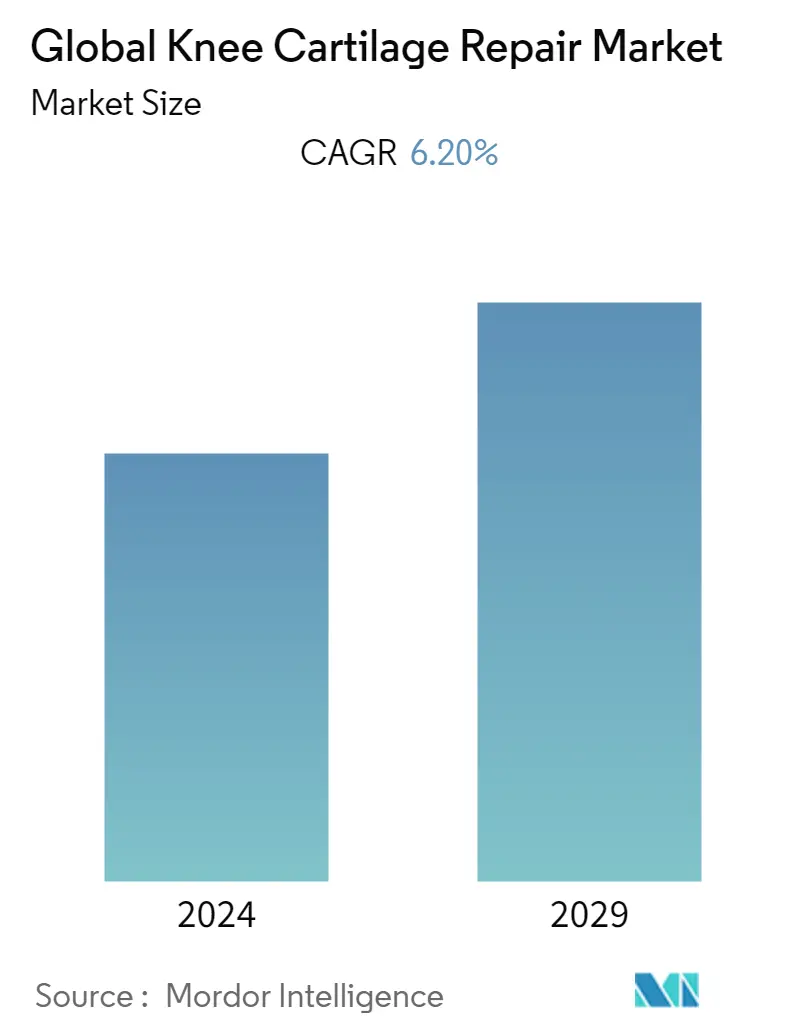Market Size of Global Knee Cartilage Repair Industry

| Study Period | 2019 - 2029 |
| Base Year For Estimation | 2023 |
| CAGR | 6.20 % |
| Fastest Growing Market | Asia-Pacific |
| Largest Market | North America |
| Market Concentration | Medium |
Major Players
*Disclaimer: Major Players sorted in no particular order |
Knee Cartilage Repair Market Analysis
The Knee Cartilage Repair Market is projected to register a CAGR of 6.2% during the forecast period (2022- 2027).
During the COVID-19 pandemic, the studied market was adversely affected due to supply chain issues and long waiting times. For instance, in August 2021, a research study titled "Impact of the COVID-19 Outbreak on Orthopedic Surgery: A Nationwide Analysis of the First Pandemic Year" stated that the number of orthopedic surgeries fell by 22.8% during the first year of the pandemic in Chile. All surgical procedures were adversely affected, with fracture and trauma surgeries being the least affected. The maximum adverse impact was seen in knee arthroplasty (-64%), followed by hip arthroplasty (-41%) and knee ligament reconstruction (-44%). The COVID-19 outbreak reduced the number of orthopedic procedures during 2020, as public health networks did have a more significant adverse impact on elective surgeries due to a slower recovery than private institutions. An increase in the waiting list should be expected, which will widen the access gap to orthopedic surgery, ultimately impacting the market growth rate over the coming years.
Factors such as the increasing geriatric population coupled with increasing road and sports-related injuries and a rising preference for minimally invasive surgeries are driving the market growth. For instance, an article published by the World Health Organization titled "Age and Health" in October 2021 stated that by 2030, 1 in 6 people worldwide would be 60 years or older. The share of the population aged 60 years and over will increase from 1 billion in 2020 to 1.4 billion. By 2050, the world's population of people aged 60 years and older will double (to 2.1 billion). The number of people aged 80 years or older is expected to triple between 2020 and 2050 to reach 426 million. Aging may hurt knee health, and thus, there will be an increased chance of knee cartilage damage and thus it will require treatment. Hence, growth in the geriatric population, thereby drive the demand for knee surgeries, in turn boosting the market's growth.
Similarly, rising road accidents are another factor augmenting the market's growth. For instance, in October 2021, the National Road Safety Authority (ANSR) stated that there was a worsening in the evolution of the indicators, with a growth of 42.5% in fatalities, in contrast to the reductions of the two previous months, and an increase of 9.1% in the number of accidents, from 2.4% for serious injuries and 11.6% for minor injuries, compared to August 2020. According to the same document, in August 2021, there were 2,996 road accidents on Portuguese roads, which caused 57 deaths, 217 serious injuries, and 3,644 minor injuries. As a result, rising injuries will increase the demand for knee cartilage treatment, driving market growth in the coming years.
Similarly, a rising preference for minimally invasive surgeries would increase market growth. For instance, in January 2021, a research study published titled "Augmented reality navigation for minimally invasive knee surgery using enhanced arthroscopy" stated that during minimally invasive knee surgery, surgeons insert surgical instruments and arthroscopy through small incisions and implement treatment assisted by 2D arthroscopic images. Compared with 2D arthroscopic navigation, the proposed augmented reality navigation reduced the targeting errors by 2.10 mm and 2.70 mm for knee phantom and in vitro swine knee experiments, respectively. Thus, with technological advancements, the preference for minimally invasive surgeries will increase and support the market's growth.
Additionally, in July 2021, the HYALEX Cartilage System by Hyalex Orthopaedics, Inc. was granted Breakthrough Device Designation by the United States Food and Drug Administration (FDA). The HYALEX Cartilage System is intended to repair cartilage defects and restore function for patients with loss of knee articular cartilage and bone requiring surgery.
Thus, the abovementioned factors will increase the market's growth in the upcoming period. However, the high cost of treatment may hinder the market's growth over the forecast period.
Knee Cartilage Repair Industry Segmentation
As per the scope of the report, cartilage damage is repaired using arthroscopic surgery, which means minimal impact on healthy parts of the knee, less scarring, and quicker recovery times. The report includes both products and therapies. The cartilage may be removed, trimmed, or smoothed down using special tools. The Knee Cartilage Repair Market is Segmented by Application (Arthroscopic Chondroplasty, Autologous Chondrocyte Implantation, Cell-based Cartilage Resurfacing, Osteochondral Grafts Transplantation, and Others), End User (Hospitals, Ambulatory Surgical Centers, and Orthopedic Clinics), and Geography (North America, Europe, Asia-Pacific, Middle-East and Africa, and South America). The market report also covers the estimated market sizes and trends for 17 countries across major global regions. The report offers the value (USD million) for the above segments.
| By Application | |
| Arthroscopic Chondroplasty | |
| Autologous Chondrocyte Implantation | |
| Cell-based Cartilage Resurfacing | |
| Osteochondral Grafts Transplantation | |
| Others |
| By End User | |
| Hospitals | |
| Ambulatory Surgical Centers | |
| Orthopedic Clinics |
| Geography | ||||||||
| ||||||||
| ||||||||
| ||||||||
| ||||||||
|
Global Knee Cartilage Repair Market Size Summary
The knee cartilage repair market is experiencing growth driven by several key factors, including an aging population, increasing road and sports-related injuries, and a rising preference for minimally invasive surgeries. The geriatric population's expansion is particularly significant, as it leads to a higher incidence of knee cartilage damage, thereby boosting the demand for knee surgeries. Additionally, the prevalence of road accidents contributes to the rising need for knee cartilage treatments. Technological advancements in minimally invasive surgical techniques are further supporting market expansion, as they offer improved outcomes with reduced recovery times. The market's growth is also supported by regulatory approvals and the introduction of innovative products designed to repair cartilage defects and restore knee function.
The North American region is currently leading the knee cartilage repair market, fueled by technological advancements, research initiatives, and product launches. The region's dominance is attributed to the increasing incidence of knee-related diseases and the development of advanced treatment options, such as 3D bioprinting and automated segmentation techniques. The market is characterized by a partial fragmentation, with several major players holding significant market shares. Companies like B. Braun Melsungen AG, ISTO Technologies, Inc., Smith & Nephew, Stryker, and Zimmer Biomet Holdings, Inc. are prominent in the market. Regulatory approvals and clinical trials for new treatments continue to drive innovation and growth, ensuring the market's expansion in the coming years.
Global Knee Cartilage Repair Market Size - Table of Contents
-
1. MARKET DYNAMICS
-
1.1 Market Overview
-
1.2 Market Drivers
-
1.2.1 Increasing Geriatric Population
-
1.2.2 Increasing Road and Sports Related Injuries
-
1.2.3 Increasing Preference for Minimally Invasive Surgeries
-
-
1.3 Market Restraints
-
1.3.1 High Cost of Treatment
-
-
1.4 Porter's Five Forces Analysis
-
1.4.1 Threat of New Entrants
-
1.4.2 Bargaining Power of Buyers/Consumers
-
1.4.3 Bargaining Power of Suppliers
-
1.4.4 Threat of Substitute Products
-
1.4.5 Intensity of Competitive Rivalry
-
-
-
2. MARKET SEGMENTATION (Market Size by Value - USD million)
-
2.1 By Application
-
2.1.1 Arthroscopic Chondroplasty
-
2.1.2 Autologous Chondrocyte Implantation
-
2.1.3 Cell-based Cartilage Resurfacing
-
2.1.4 Osteochondral Grafts Transplantation
-
2.1.5 Others
-
-
2.2 By End User
-
2.2.1 Hospitals
-
2.2.2 Ambulatory Surgical Centers
-
2.2.3 Orthopedic Clinics
-
-
2.3 Geography
-
2.3.1 North America
-
2.3.1.1 United States
-
2.3.1.2 Canada
-
2.3.1.3 Mexico
-
-
2.3.2 Europe
-
2.3.2.1 Germany
-
2.3.2.2 United Kingdom
-
2.3.2.3 France
-
2.3.2.4 Italy
-
2.3.2.5 Spain
-
2.3.2.6 Rest of Europe
-
-
2.3.3 Asia-Pacific
-
2.3.3.1 China
-
2.3.3.2 Japan
-
2.3.3.3 India
-
2.3.3.4 Australia
-
2.3.3.5 South Korea
-
2.3.3.6 Rest of Asia-Pacific
-
-
2.3.4 Middle-East and Africa
-
2.3.4.1 GCC
-
2.3.4.2 South Africa
-
2.3.4.3 Rest of Middle-East and Africa
-
-
2.3.5 South America
-
2.3.5.1 Brazil
-
2.3.5.2 Argentina
-
2.3.5.3 Rest of South America
-
-
-
Global Knee Cartilage Repair Market Size FAQs
What is the current Global Knee Cartilage Repair Market size?
The Global Knee Cartilage Repair Market is projected to register a CAGR of 6.20% during the forecast period (2024-2029)
Who are the key players in Global Knee Cartilage Repair Market?
B. Braun Melsungen AG, ISTO Technologies, Inc., Smith & Nephew, Stryker and Zimmer Biomet Holdings, Inc. are the major companies operating in the Global Knee Cartilage Repair Market.

